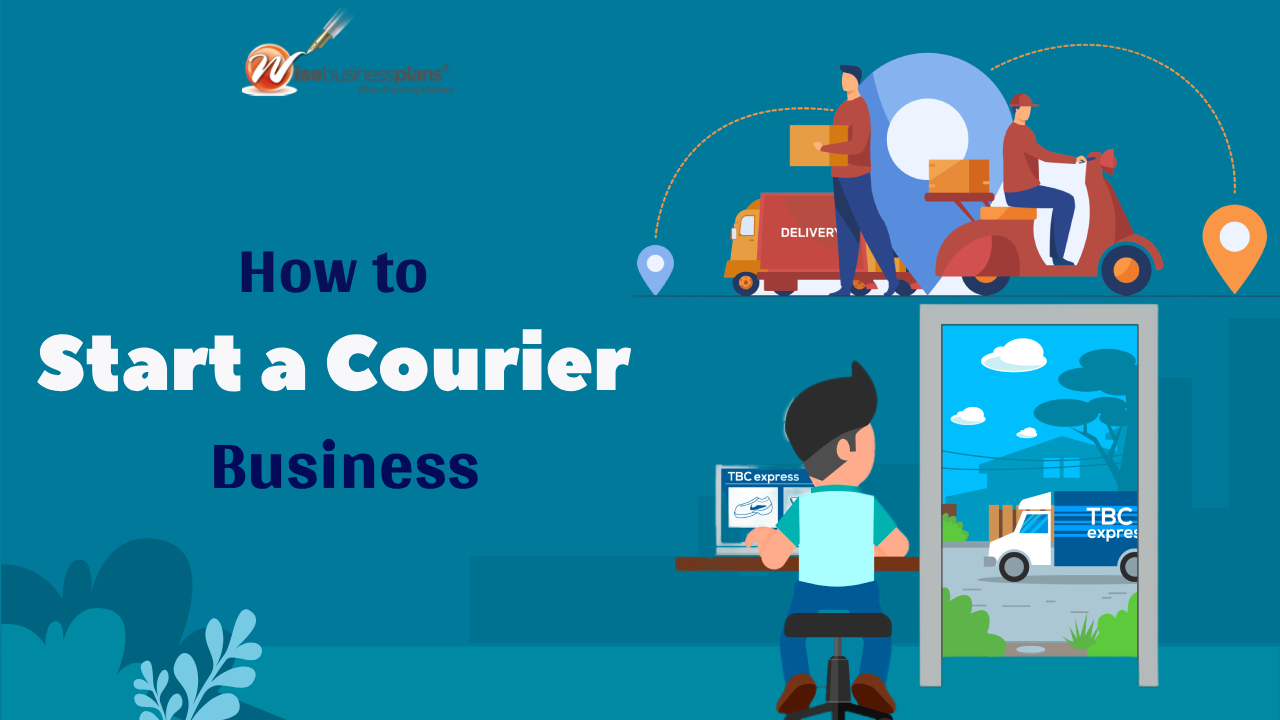How to Start a Courier Business
Table of Contents
- What is the Role of a Courier?
- How Much Money Can I Make as a Courier?
- Revenue Model for a Courier Business
- 14 Steps to Start a Courier Business Successfully:
- 1. Choosing the Right Vehicle
- 2. Get the Right Equipment
- 3. Create a Courier Business Plan
- Need Help Writing a Business Plan?
- 4. Find your Area of Expertise
- 5. The Legal Framework
- 6. Your Business Name
- 7. Get Your Business Insured
- 8. Branding of your Business
- 9. Set your Prices
- 10. Provide Outstanding Customer Service
- 11. Keep Track of your Customers
- 12. Keep Track of your Spending
- 13. Open a Bank Account for Your Business
- 14. Promoting Your Courier Business
- FAQs:
Many advancements in the e-commerce and online retailing space have fueled courier industry expansion during the last five years.
Shipping volumes are likely to rise as more people purchase on websites like Amazon and eBay Inc., which rely heavily on industry services to move their goods. As a result, industry revenue is expected to grow at a 4.5 percent annual rate to $157.3 billion over the next five years.
Additionally, seasonal holiday spending has increased due to improved economic conditions, resulting in increased income for courier businesses.
Furthermore, the continuous rise of e-commerce and the decrease of brick-and-mortar retailers will almost certainly benefit industry players.
It’s never easy to start your own business, and we hope that by making informed decisions and avoiding common pitfalls, you can get off to a good start. To create your own successful courier business, follow these steps.
What is the Role of a Courier?
For businesses and people, a courier pick’s up and deliver’s products, documents, and even pets, even in small towns. This service is always in demand because someone needs a product or paper delivered today. Independent local couriers can provide services that are in high demand but unavailable from large delivery companies such as UPS or FEDEX.
A courier business is the ideal “shoestring startup” because it requires very little capital, no professional experience or education, and only the ability to communicate clearly with consumers to get started. Your new courier business can be run from your house, saving you money on rent and utilities.
The list of possible clients is nearly limitless. Architects, engineers, contractors, printers, doctors and medical labs, grocers, pharmacies, caterers, flower shops, accountants, attorneys, busy people who don’t have time to conduct errands, and homebound people who are recovering from an accident or sickness.
How Much Money Can I Make as a Courier?
The national average hourly wage for courier services in a “light” vehicle, such as a sedan, pickup truck, or minivan, is roughly $36.
Working 8 hours a day for a week equals $1440, or $72,000 annually. Mileage and service costs can easily add another 10% to 20%.
In the past, Most people have been disappointed by the contents of e-books, but this one is simple to read, comprehensive, and full of useful suggestions and strategies. It was quite helpful in getting your local courier business off the ground.
Revenue Model for a Courier Business
You don’t usually start a courier business solely for “community benefit“. Whether it’s a side business or a full-time profession, you want it to be profitable.
When you build up your courier service with that purpose in mind, it has the potential to be quite profitable.
For your new courier firm, you have numerous revenue and business models to choose from:
- Peer-to-Peer: Your company sells access to a technology platform that allows two people to communicate with one other. They work out the details of the delivery on their own once the connection is made, and you either get a share of the sale or charge users a fee to use the site.
While the model’s ongoing overhead costs are modest, margins are tight and profitability is difficult to achieve.
- Business-to-Consumer: A solution that assists businesses in delivering directly to their clients is in high demand. Businesses are looking for quick and effective ways to deliver their products straight to people’s homes and offices, as more people are staying closer to home.
This strategy offers more earning potential as a courier than peer-to-peer. It may help the businesses you serve to pivot their operations to combat declining in-store transactions.
- Subscription-Based: You set a monthly rate for unlimited delivery and charge it to your consumers. This is excellent for the customer, but not so much for you if you have a lot of deliveries to do. With this arrangement, your earnings per delivery can vary.
- Business-to-Business: This is a more specialized approach, but it has a lot of possibilities. This is ideal for assisting caterers in delivering meals, suppliers in delivering supplies, and employers in delivering work items and paperwork to remote employees.
14 Steps to Start a Courier Business Successfully:
1. Choosing the Right Vehicle
To launch your courier service, you will need a reliable means of transportation. For this type of delivery service, cargo vans are often chosen by full-time couriers as they offer the most cargo space for transporting the items you are carrying for customers.
To lower your monthly payments, we suggest that you lease a van or look for a used cargo van. As an alternative, a pickup truck with a covered bed can also be a great option.
2. Get the Right Equipment
You can make your courier business more efficient and save your back from back-breaking labor by investing in the right equipment. The type of equipment you need depends in part on what you will pick up and deliver for your customers.
A simple dolly or hand truck is essential if you mostly deliver parcels or boxes. You can buy a standard dolly for about $20 at major retailers or you can purchase moving equipment online here and have it delivered by Amazon. Other items you may need include cargo straps, moving blankets, and tape.
3. Create a Courier Business Plan
Compiling a thorough business strategy will serve as a valuable guide during the initial few months of operation. If you need to borrow money to start your courier service, a business plan can also assist you to acquire funding.
Need Help Writing a Business Plan?
You no longer have to worry about the complexities of writing a professional business plan. Our MBA-qualified business plan writers have written over 15000+ business plans for over 400 industries in over a decade.
Hire a professional business plan writer now
4. Find your Area of Expertise
To ensure success, create your own “niche“. If you live in a city with a lot of established courier service companies, this is a must-do step. Even if you live in a tiny town, it will give you a “head start” on finding new customers.
Find out what your prospects want, whether they’re lawyers who need same-day document delivery or caterers who need cooked meals delivered every day at a specific time, and then give it to them at a reasonable price.
Giving clients what they need or want is the key to any business’s success. Filling the UPS/FEDEX gap by providing same-day local delivery to local businesses is one of the best niches.
5. The Legal Framework
It is critical to choose a legal framework for your new courier service before you begin. Will you run it as a single proprietorship, a limited liability company, or a corporation?
Before you apply for a business license in your town or state or obtain a federal tax identification number, you must first complete this step.
After you’ve chosen the legal structure of your courier firm, you’ll need to register it with the appropriate authorities.
6. Your Business Name
The business name you choose should reflect your company’s values and mission. Be sure you verify with the secretary of state in the state where you intend to do business to make sure the name you choose for your courier business isn’t already taken by another company.
You should also check sites like GoDaddy to see if the domain name for the business you desire is available. After you’ve decided on a name for your company, you’ll need to form a legal entity.
If you are the sole proprietor of your company, a sole proprietorship may be the best option. An LLC (limited liability corporation) may be a better choice if you have business partners.
LegalZoom is a useful tool for determining whether your business name is already taken and registering your company with the state.
7. Get Your Business Insured
Your courier service will require business insurance, cargo insurance, and maybe liability insurance for your vehicle. Having insurance coverage is also necessary for establishing client trust. Many companies and individuals will not use a courier service that is not fully insured.
To find out how much it will cost to insure your business, contact a local commercial insurance broker. This fee varies depending on your location, the types of deliveries you make, and the risk you’re willing to take.
8. Branding of your Business
Develop strong branding for your firm to separate yourself from competitors, such as having a specific-colored fleet of vehicles or a company uniform, in addition to having a logo, an internet presence, and a digital and local marketing strategy.
If you want to hire people, you should start looking for them now. You won’t be able to accept essential phone calls or run the workplace if you’re out on the road delivering packages.
You won’t be able to accept essential phone calls or run the workplace if you’re out on the road delivering packages. You may need to hire personnel to oversee deliveries or assist with additional administrative work to run a successful courier business.
9. Set your Prices
Many new couriers make the mistake of not charging enough to cover all of their expenses since they haven’t been in the company long enough to be aware of all of the small charges, such as a business license renewal fee, that may add up to a lot of money over a year. Bookkeeping costs, social security taxes, and vehicle maintenance are just a few examples.
To arrive at a suitable rate that allows you to profit while still making your clients happy, remember to add roughly 30-35 percent to the salary you’ll be paying yourself. After a few months, revisit your rates to check whether they still provide you with the net hourly rate you desire. The current national average hourly wage is $36.
10. Provide Outstanding Customer Service
If you provide excellent service to your consumers, you will succeed and soon have all the customers you can handle. If you say you’ll be there in two hours, aim for 90 minutes. Your consumers will adore it and tell their friends about you.
11. Keep Track of your Customers
Use a free scheduling software application like checkappointments.com or clickbook.net to keep track of your customers and deliveries.
Another option is to use one of Google’s or Microsoft’s calendar tools. You can also use them to get paid online with PayPal for a little monthly charge. Naturally, you may use it on your smartphone while making deliveries.
12. Keep Track of your Spending
There are programs to help you do your bookkeeping like the software programs for scheduling. Outright.com, which costs roughly $10 a month and even alerts you when taxes are due or when you forget a deduction, is my favorite.
It makes keeping track of your small business finances simple, even if you can’t add or subtract.
Hira a professional accountant at Wisebusinessplans to keep track of your business performance
13. Open a Bank Account for Your Business
You may wish to open a business bank account to keep business expenses and profits separate from personal cash.
You must have registered your business and produced documentation of registration to create a business bank account in the United States.
14. Promoting Your Courier Business
It’s time to start marketing your courier service now that you have your truck, equipment, and name. To begin, use social media networks such as Facebook, Twitter, and LinkedIn to communicate with your friends and family.
On each of these social media platforms, you should create a business page.
Most courier companies will have to market to other companies who need a courier.
This can be accomplished by creating a list of firms that might want a courier service, then cold phoning and emailing prospects, or dropping off business cards.
- Create a Website: This is most likely how consumers will book your services. Make becoming a customer as simple as possible for them. Create a website where customers may make immediate reservations. It should support e-commerce so that customers can pay for your services and track their deliveries.
- Online Marketing: Online advertising and marketing can be a low-cost and effective approach to reaching out to business owners. Self-serve solutions are available for Google AdWords and Facebook. Customers can be targeted based on the keywords they search for, as well as their interests, demographics, and geographic region.
- Stay Active on Social Media: Select a few social media accounts to which you will post and interact on a regular basis. Through your social media presence, people will get a sense of your beliefs and brand. It could also turn into a captive audience to whom you can sell afterward.
- Begin Collecting Emails: When you have a new customer, ask for their email address so you may send them your newsletter. Make certain to ask them to opt-in, as this is a legal requirement in Canada. So you’re top-of-mind when they need a courier, send them promotions, company news, and helpful information.
- Automatically Sending Delivery Notifications: People want to be able to track their deliveries in real-time. An SMS message can be significantly more successful than sending an email notification (which will simply get lost in people’s inboxes).
- Referrals: Ask for referrals once you’ve established your “core” clientele and have treated them properly for a period. Inform them that your company is still expanding and that you could use a few more good customers like them. In exchange for a reference who becomes a regular, recurring customer, provide free delivery or a discount on a month’s subscription.
77% of customers think businesses that text them their order information are more trustworthy. When you satisfy your present clients, they will tell others about you, and your firm will receive more referrals. There’s a reason why they say “word-of-mouth advertising works“.
FAQs:
The initial steps include conducting market research, creating a business plan, obtaining necessary licenses and permits, purchasing or leasing vehicles, and establishing partnerships with clients and vendors.
The specific licenses and permits needed may vary depending on your location. Generally, you’ll need a business license, commercial driver’s license (CDL), and potentially permits related to vehicle operation and transporting goods.
Vehicles can be acquired through purchasing or leasing options. Consider factors such as size, fuel efficiency, maintenance costs, and branding opportunities when selecting vehicles for your fleet.
Utilize online and offline marketing strategies such as creating a professional website, leveraging social media platforms, attending industry events, reaching out to local businesses, offering competitive pricing, and providing reliable and efficient delivery services.
Key considerations include optimizing delivery routes for efficiency, implementing robust tracking and communication systems, hiring reliable and skilled drivers, providing excellent customer service, and adapting to changing market demands and technologies.
















